Impact of Birth Weight on Psychological Development
Heather M. Wilde
Abstract
Have you every wondered if birth weight would be a factor in determining a person�s personality? Eighty-four college students (28 males and 56 females) at a small mid-western school were surveyed about their personality and birth weight. (Personality was operationalized as self-rating on a Likert scale) Additional data indicated if they were premature and type of birth (c-section or naturally). Introversion, dependency, self-esteem, and need for cognition were also analyzed by use of a questionnaire. The research indicated that low birth weight does not correlate with introversion (t= -.745, p value is not significant @ .458). The research also indicated that low birth weight does not correlate with dependency (t= -.218, p value was not significant @ .828). Type of birth did not correlate with type A personality (t= 1.79, p value was not significant @ .079). Time in the womb did not correlate with introversion (t= .662, p value was not significant @ .510). People who are low birth weight could still have different personalities than non-low birth weight people, even though the hypotheses are not significant. This study is still important since one reason the hypotheses are not significant is the low sample size of low birth weight participants. If the sample would have been larger and proportional, one of the hypothesis might have been significant.
Impact of Birth Weight on Psychological Development
Have you ever wondered why certain people have certain personalities? Everyone is born with different personalities. There are some main categories of personalities and everyone has varying degrees of the categories. Some of the categories are introversion, dependency, self-esteem, need for cognition and type A personality. All of theses personalities can be at different intensities. There are many different variables to explain why personalities could be different in people. The two variables that will be looked at in this study are birth weight and length of pregnancy. The reason birth weight was chosen was because the researcher was low birth weight and interested to see if other low birth weight children have the same personality.
Introversion
People are either introverted or extroverted. Introversion is defined as not being outgoing, keeping to yourself, and wanting time to yourself a lot. Nakao, et al. (2000) did a study with 150 children (104 males and 46 females). He found that extraversion, which is the opposite of introversion, was negatively associated with age, but no sex difference. He also found that extraversion was low for the children who experienced overprotection, which would mean that they were introverted. This would make sense since then the parents would not let their children do things on their own by overprotecting them. When fathers helped in the rearing of the children the introverts matured more than the extroverts (Nakao, et al., 2000). Maternal participation influenced the extraverts intellect. He also found that extraversion was more determined by genetic effects and chance than maturity. Introverts are impacted by family environment more than extroverts. This also makes sense since the introverts do not go out and explore as much as introverts. The introverts would stay at home and that would impact them more than the children that are extroverts.
Self-esteem
Self-esteem is how good someone feels about himself or herself. �Self-esteem is �how much a person likes, accepts, and respects himself [sic] overall as a person�� (Chubb, 1997). A person can either have high self-esteem and feel good about himself or low self-esteem and not feel good about himself. Francis (1997) had 314 males and 488 females that were 16 years old and from England. They completed the Coopersmith�s Self-Esteem Inventory and an extraversion scale. Francis (1997) found that there is a significant positive correlation between self-esteem and extraversion. One possibility is that individuals with high scores on self-esteem are more sociable and impulsive. This would make the two dimensions correlate together.
Chubb (1997) did a longitudinal study with 174 high school students (99 males and 75 females). The study was done through the four years of high school. The Rosenberg Self-Esteem Scale was used and it has ten items on it. There are four answers for the self-esteem scale, strongly agree, agree, disagree, and strongly disagree. There was no significant difference between gender and grade. Males had higher self-esteem than females through all four years. This makes sense since the females are more judgmental during the high school years than males are. Self-esteem also did not significantly change over time. The self-esteem was almost the same for each person for all four years.
Dependency
Dependency is when a person relies on someone else to help him or her through day. Dependent people have a hard time doing anything by themselves. Grilo et al. (1998) researched young adults and adolescents psychiatric inpatients. According to Grilo et al. (1998), young adults have more dependency problems than adolescents. This was surprising since adolescents have more relationship problems than young adults. Adolescents are defined as 12 to 17 and young adults were 18 to 37. The two groups were given Personality Disorder Examination to see if they have personality disorders.
Need for
Cognition
Need for cognition is the characteristic that is very high for people that love to think. Loving to do puzzles and figuring things out are also characteristics of need for cognition. According to Crawford and Skowronski (1998), a person that has a high need for cognition remembers more stereotype consistent information than people that has a low need for cognition. People that are high in need for cognition are more likely to use stereotyped ideas to think about the information, which helps the memory. Therefore, people that have a high need for cognition have an easier time memorizing than low need for cognition people.
Type A
personality
Type A personality people are always very organized, have rigid time schedule, competitive, and always on the move. The other personality is Type B, which is the exact opposite of Type A. People of all ages demonstrate these personalities. A person can be somewhere in between Type A and Type B personality or they can be strict Type A or Type B. Kline (1995) passed out surveys to 195 females and 45 males to see their indication on competitiveness of themselves. Competitive is one characteristic of Type A personalities. There was no significant difference between the genders and the competitive scale, but the mean for males was higher than females, which means they are more competitive. Since it is not significant, it is just a trend that males are more competitive.
Low Birth
Weight
A low birth weight person is a person that weighed 5.5 pounds or less at birth. According to San Mateo County Community Health Assessment in 1992, 5.7% of babies born were low birth weight. Breslau and Chilcoat (2000) looked at the relationship between low birth weight and psychiatric problems. The researchers found children at age 6 and followed the children five years later at age 11. They did a random sample of 823 children and found that the low birth weight children have more attention problems at age 11 than non-low birth weight children. This was higher in urban children than non-urban children, which means there could be an interaction between the biology of the child and the environment.
Every child has a particular temperament, but have you ever wondered if the birth weight has anything to do with it? Medoff-Cooper (1986) found that for 41 infants at 6 and 12 months of age there is a difference between the very low birth weight children and the non-low birth weight children. Very low birth weight children are children that weighed 3.3 pounds or less at birth. They used the Infant Temperament Questionnaire to determine their temperament. At 6 months of age, the very low birth weight children were less flexible and more forceful than full-term infants. At 12 months, the very low birth weight infants were less persistent than the full-term infants. Medoff-Cooper (1986) found that the very low birth weight children are different in behaviors they show than the full-term infants, but they will grow out of it.
Blake et al.�s (1975) research was with 160 babies of very low birth weight, 3.3 pounds or less. He found that more than he expected in regard to children being mildly over-dependent, shy, and anxious. Medoff-Cooper and Schraeder (1982) studied 26 very low birth weight infants and 42% of the infants were at risk for developmental delays. They found that the infants were significantly more difficult than full-term infants. A negative relationship was between the infants with difficult behavioral style and maternal involvement. This shows that even though the mother was involved the children still had a difficult behavioral style.
Walker (1989) compared the behavior of 18 pre-term three year olds with 18 full-term three year olds. The pre-term children were eight to three weeks early and 3.3 pounds to 5.5 pounds at birth. The researcher measured the behavior with a behavior questionnaire. Walker (1989) found out that the pre-term group had significantly more problems with dependence. Goldstein (1988) researched premature very low birth weight three year olds. There were 40 three year olds in the study. The results show that there is no difference between very low birth weight and full-term children in regard to difficult children, easy, or slow to warm up. The premature infants were rated less rhythmic than the full term infants (Goldstein, 1988).
Sommerfelt, Ellertsen, and Markestad (1993) looked at 29 very low birth weight infants and personality characteristics compared to the 29 full term infants. The 29 very low birth weight infants in the study were from a lower socioeconomic status. They gave the infants a personality inventory for children and the low birth weight children had more learning difficulties and school coping problems. The low birth weight boys had more emotional problems than the 29 full term children. This says that the low birth weight children have a harder time in adjusting in school and have a harder time adjusting to life.
Klebanov, Brooks-Gunn, and McCormick (1994) studied the classroom behavior during elementary school with the effect of birth weight. There were four groups in their study extremely low birth weight, children who weigh 2.2 pounds or less at birth, very low birth weight, children who weigh 3.3 pounds or less at birth, high low birth weight, children who weigh 5.5 pounds or less, and normal weight children, children weighing more than 5.5 pounds. There were 137 extremely low birth weight children, 223 very low birth weight children, 434 high low birth weight, and 326 normal birth weight. The results of the study were found to be the extremely low birth weight children have a lower attention and language skills than all other groups. All low birth weight children had lower attention and language skills and higher daydreaming and hyperactivity than normal birth weight children. Girls had fewer behavior problems than males (Klebanon et al.). This is very interesting since usually girls are usually having more problems than males.
Brothwood et al. (1986) found that very low birth weight boys had significantly higher mortality rate than girls. It was also found out that the boys that did survive had more health problems. Since the boys had more problems, they are behind on their development levels. �More than twice as many boys as girls had major neurodevelopmental disorders� (Brothwood et al, 1986). If boys had more problems, then there would be more low birth weight girls in the world and there should be more girls in my sample.
Current Study
All the previous research about the personality characteristics relate to my study because the research deals with the certain personality characteristic that I will also deal with in my research. The only problem with the previous research with the personality characteristics is they did not take into effect birth weight to see if that had an impact. The previous research with low birth weight is relative to this study since both the previous research and my study deal with low birth weight, but they do not look at the same personality characteristics as my study does. Another factor that the low birth weight studies did not look at was they were looking at children and my study looks at college students.
In the current study, a group of college students filled out a survey their ratings on different questions for the personality characteristics and their birth weight. The study was done to see if low birth weight children have a different personality than non-low birth weight children. The hypothesis is that low birth weight people will have more psychological development problems than non-low birth weight people. The hypotheses that were researched were:
1) Low birth weight participants will be more introverted than non-low birth weight participants.
2) Low birth weight participants will have lower self-esteem than non-low birth weight participants.
3) Low birth weight people will be more dependent than non-low birth weight people.
4) Low birth weight people will have a lower need for cognition than non-low birth weight people.
5) Low birth weight people will be more Type A personality than non-low birth weight people.
6) People who are born early will be more introverted than people not born early.
7) Participants who are born by c-section will be more Type A personality than natural birth participants.
The hypothesis will be controlled by giving it to college age students, equal gender ratios, and the same survey. The independent variable is the birth weight and the children born early and the dependent variables are the personality characteristics, like introversion, dependency, self-esteem, need for cognition, and Type A personality. The study is proportional to the national average of low birth weight participants to the population.
Method
Participants
Eighty-four college students from a small mid western college that participated in the study. The research began with 105 surveys being distributed, but not all the surveys were returned (80 % returned). The participants were 28 males and 56 females, who were in the four introductory psychology classes. Thirty-nine students were in the first professor�s classes and 55 students were in the second professor�s classes. The percent of the participants who were low birth weight (weighing less than 5.5 pounds) was 10.7%. This percent was higher than the natural average of low birth weight people, which is 7.4% (Kid�s Count 2000). The mean weight for the low birth weight participants is 3 pounds 13 ounces and the mean weight for non-low birth weight participants is 7 pounds11 ounces.
Survey
The students were given a survey, which consisted of 39 questions. The survey had questions about their gender, birth weight, if they were born early, and if they were born by c-section or naturally. Personality characteristics were also evaluated in the survey. The personality characteristics that were evaluated at were introversion, dependency, self-esteem, need for cognition, and type A personality. (See Appendix A.)
For introversion, the participants were asked different words that are characteristic of introverts or extroverts. Then they marked on a Likert scale, one being strongly disagree and seven being strongly agree, which word was most like their personality. Six questions made up the introversion scale, which had a mean of 18.4 and range of 8-36. The higher the score the more introverted the participant is. The introversion scale had a reliability of 0.806.
The dependency scale was created by personality characteristics of dependent people and it was on a Likert scale also. Dependency has a mean of 27.8 and range of 12-44 for the eight-item scale. The higher the score the more dependent the person is. The dependency scale had a reliability of .506.
Self-Esteem was based on the Rosenberg Scale (1965). A total was created for the ten item Likert self-esteem scale and the mean was 54.7, with a range of 22-70. A high score means high self-esteem. Self-esteem had a reliability of .845.
The Need for Cognition scale was based on Cacioppo and Petty�s Need for Cognition scale (1982). A total was created for the 10 items and it had a mean of 43.6 and a range of 24-64. A high need for cognition was a result of a high score from the 10 items. The need for cognition scale had a reliability of .804.
The last section of the survey, about Type A personality consisted of two lists, one for characteristics of Type A personality and one list for Type B personality. The participants looked at the lists and then rated the lists on a Likert indicating similarity to their personality. The mean for Type A personality was 3.6 and had a range of 1-7. (7=Type A, 1= Type B).
Some of the questions for the personality characteristics had to be recoded since the researcher used counterbalancing to avoid response bias. The surveys were completed by a wide cosssection of freshman, since most are required to take the �Introduction to Psychology� course.
Procedure
One professor told the students to take the survey home with them and fill it out after they figure out their birth weight, their mother�s length of pregnancy, and the method of birth. After the surveys were completed, they were turned back in. With the second professor�s classes the researcher told students that they needed to find out their birth weight, their mother�s length of pregnancy, and their method of birth before the surveys were handed out. Then five days later the researcher went into the class, handed out the surveys, and collected them after the participants were done. The researcher handed out the surveys the different way the second time because some surveys were not returned when they were not filled out in class. The researcher was trying to increase her return rate. The survey took approximately 5 minutes to fill out.
Results
Birth Weight & Introversion
A t-test was run to research the relationship of birth weight and introversion. The mean was 16.8 for low birth weight participants and 18.4 for non-low birth weight participants. (See Figure 1). The means were on a scale from 6 to 42, with the higher numbers being more introversion. The relationship was not significant at the .05 level (t (76) = -.745, p= .458).
Figure 1
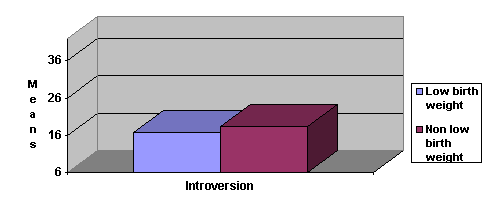
Relationship of Introversion and Birth Weight
Birth Weight & Self-Esteem
A t-test was also run on birth weight and self-esteem. The mean was 55.4 for low birth weight participants and 54.9 for non-low birth weight participants. (See Figure 2) The scale for the means was from 10 to 70. The higher the number the more self-esteem the participant had. The relationship was not significant at the .05 level (t (75) = .153, p= .879).
Figure 2
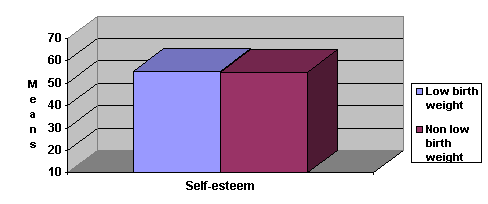
Relationship of Self-esteem and Birth Weight
Birth
Weight & Dependency
A t-test was run to compare birth weight and dependency. The mean was 27.2 for low birth weight participants and 27.7 for non-low birth weight participants. (See Figure 3) The range for dependency was from 8 to 56, with the higher numbers representing more dependency. The relationship was not significant at the .05 level (t (76) = -.218, p= .828). Comparing the lowest third of birth weight to the highest third, the mean is 25.85 for the lowest third and 29.72 for the highest third. The relationship was significant at the .05 level (t (49) = -2.01, p = .050).
Figure 3
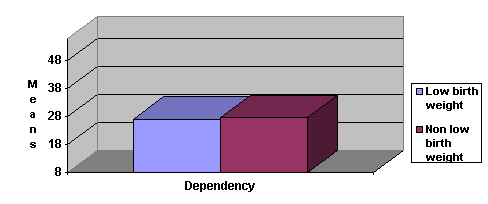
Relationship of Dependency and Birth Weight
Birth Weight & Need for Cognition
A t-test was run between birth weight and need for cognition. The mean for low birth weight participants was 42.4 and 43.8 for non-low birth weight participants. (See Figure 4) The range for need for cognition was 10 to 70, with the higher the score the more need for cognition. The relationship was not significant at the .05 level (t (75) = -.383, p= .703).
Figure 4
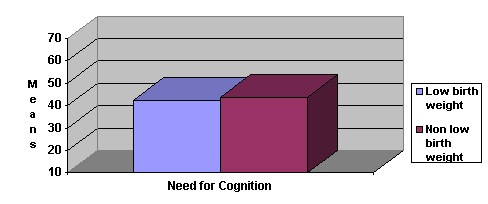
Relationship of Need for Cognition and Birth Weight
Birth
Weight & Type A Personality
A t-test was run between birth weight and type a personality. The mean for low birth weight participants was 2.88 and 3.68 for non-low birth weight participants. (See Figure 5) The range for type a personality was from 1 to 7, with 7 being Type A personality and 1 being Type B personality. The relationship was not significant at the .05 level (t (71) = -1.22, p= .277).
Figure 5
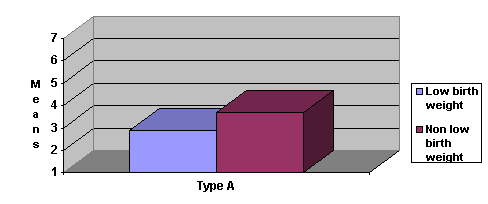
Relationship of Type A Personality and Birth Weight
Length of
Pregnancy & Introversion
A t-test was run between length of pregnancy and introversion. The mean was 19.1 for early birth participants and 17.9 for participants not born early. The range for the means was 6 to 42. The higher the number the more introverted the participant is. The relationship was not significant at the .05 level (t (68) = .662, p= .510).
Method of
Birth & Type A Personality
A t-test was run between method of birth and type a personality. The mean for c-section birth was 3.96 and 3.14 for natural birth. The means had a range of 1 to 7, with 7 being Type A personality and 1 being Type B personality. The relationship was not significant at the .05 level (t (57) = 1.79, p= .079).
Discussion
Overview
Based on the results none of the hypotheses are significant. Looking at the means for introversion, non-low birth weight participants are more introverted than low birth weight participants are. This is the opposite of what the researcher predicted. This surprised the researcher because low birth weight babies spent more time by themselves in incubators and would be more introverted.
Looking at the means for self-esteem, low birth weight participants had higher self-esteem than non-low birth weight, this was also opposite of what the researcher predicted. The researcher thought that the participants that were low birth weight would have lower self-esteem. The reason is the low birth weight participant might have been more likely to have a parent do more for them since maybe they had problems as they were growing up because of their weight. Looking at the means for dependency, non-low birth weight participants had a higher score than low birth weight. This also surprised the researcher since it was in the opposite direction of the hypothesis. By comparing the lowest third of the participants on weight and the highest third of participants on weight, there was a significant difference. The means were higher for the heavier participants indicating that the highest third was more dependent than the lowest third.
Looking at the means for need for cognition, low birth weight had a lower need for cognition, which is what the researcher predicted. The means for Type A personalities indicate that non-low birth participants were more type A than low birth weight participants were, which is the opposite of the direction predicted by the hypothesis. This surprised the researcher since low birth weight children would be more competitive and aggressive, which are characteristics of Type A personality. The reason is low birth weight children would have to be more competitive and strive harder in life since they are at a disadvantage with their low birth weight.
Looking at the relationship between introversion and early births, the participants that were born early were more introverted than the participants not born early, which is what the researcher predicted. Looking at the means for Type A personality and method of birth, c-section participants were more Type A than natural birth participants were. This also agreed with the hypothesis.
Limitations
The major problem of the study was not having a large enough sample size for low birth weight. The study composed of only nine low birth weight participants, which was only 10.7% of the sample. Another problem with the study was non-response bias. The reason they were not handed back maybe because some of the participants did not know their birth weight or forgot to look and turn the survey back in. Another problem was that the sample was mostly freshman at a small mid-western college, which may not be indicative of the population in general. Some of the low birth weigh people in the world might not make it to college. Another problem was it was with mostly only one age range. The last problem was that there could be environmental factors that help develop a personality and that there is not just one factor influencing it.
Future
Research
Future research could be done with a larger sample size of low birth weight participants. Another thing that could be done is to have different age participants. Some personality characteristics could be evaluated at different ages. Another idea is use more variety of personality tests to see if low birth weight participants have a certain personality. There were only five personality characteristics measured in this study. Future research could also be done with people in different geographic location. Another idea is to see which parent mostly raised the child to see if that has an impact. Future research could also be done with low birth weight children in daycare and not in daycare. This could be done to see if parents influence on the low birth weight children had an impact. Future research could also be done by isolating only one variable, birth weight, and controlling all other variables. Twin studies might be the direction of for this kind of research.
Summary
This research even though it was not significant, does not agree with Medoff-Cooper (1986) because Medoff-Cooper says that low birth weight infants were less flexible and more forceful, which are characteristics of Type A. In this study, the researcher also found that more low birth weight participants were Type B. The reason that the researcher says that the low birth weight participants were more Type B is because the means for low birth weight were lower than the means for non-low birth weight participants. The lower score means more Type B personality. By looking at the results of this study, doctors could maybe use this research and learn which personality the child will be more like based on their birth weight. By knowing this, he or she will be able to help the parents by telling them what the personality of their child would most be like.
References
Blake, A., Stewart, A., & Turcan, D. (1975). Parents of babies of very low birth weight: long-term follow-up. Ciba Foundation Symposium, 33, 271-88.
Breslau, N., & Chilcoat, H. D. (2000). Psychiatric sequelae of low birth weight at 11 years of age. Biological Psychiatry, 47, 1005-11.
Brothwood, M., Wolke, D., Gamsu, H., Benson, J., & Cooper, D. (1986). Prognosis of the very low birth weight baby in relation to gender. Archives of disease in childhood, 61, 559-64.
Chubb, N. H., Fertman, C. I., & Ross, J. L. (1997). Adolescent self-esteem and locus of control: A longitudinal study of gender and age differences. Adolescence, 32, 113-129.
Crawford, M. T., & Skowronski, J. J. (1998). When motivated though leads to heightened bias: High need for cognition can enhance the impact of stereotypes on memory. Personality & Social Psychology Bulletin, 24, 1075-1088.
Francis, L. J. (1997). Coopersmith�s model of self-esteem: bias toward the stable extravert. The Journal of Social Psychology, 137, 139-42.
Goldstein, D. J., & Bracey, R. J. (1988). Temperament characteristics of toddlers born prematurely. Child: Care, Health and Development, 14, 105-9.
Grilo, C. M., McGlashan, T. H., Quinlan, D. M., Walker, M. L., Greenfeld, D., & Edell, W. S. (1998). Frequency of personality disorders in two age cohorts of psychiatric inpatients. American Journal of Psychiatry, 155, 140-2.
Klebanov, P. K., Brooks-Gunn, J., & McCormick, M. C. (1994). Classroom behavior of very low birth weight elementary school children. Pediatrics, 94, 700-89.
Kline, T. J. B. (1995). Cooperativeness and competitiveness: dimensionality and gender specificity of the classroom life instrument. Educational and Psychological Measurement, 55, 335-9.
Medoff-Cooper, B. (1986). Temperament in very low birth weight infants. Nursing Research, 35, 139-43.
Medoff-Cooper, B., & Schraeder, B. D. (1982). Developmental trends and behavioral styles in very low birth weight infants. Nursing Research, 31, 68-72.
Nakao, K., Takaishi, J., Tatsuta, K., Katayama, H., Iwase, M., Kazuhiro, Y., & Takeda, M. (2000). The influences of family environment on personality traits. Psychiatry and Clinical Neurosciences, 54, 91-95.
1999 Kids Count Online. (2000, June). The Annie E. Casey Foundation. Retrieved November 4, 2000 from the World Wide Web: http://www.aecf.org/kidscount/kc1999/findings.htm#low.
San Mateo County Community Health Assessment. Retrieved October 29, 2000 from the World Wide Web: http://www.pls.lib.ca.us/healthysmc/6/56.html.
Sommerfelt, K., Ellertsen, B., & Markestad, T. (1993). Personality and behaviour in eight-year-old, non-handicapped children with birth weight under 1500 g. Acta Paediatrica, 82, 723-8.
Walker, J. (1989). The behaviour of 3-year-old children who were born preterm. Child: Care, Health & Development, 15, 297-313.